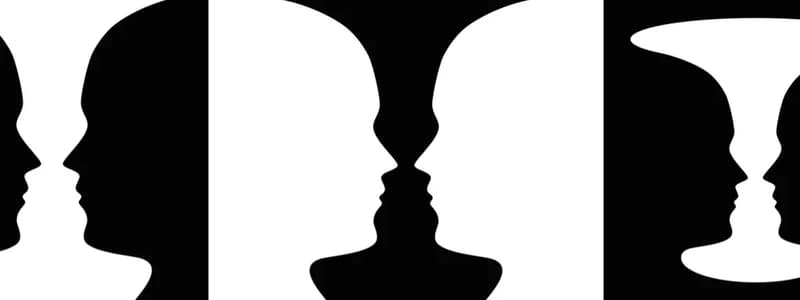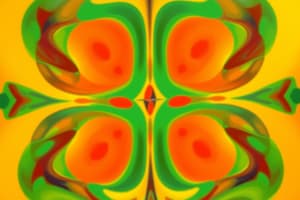Podcast
Questions and Answers
Which of these is NOT a Gestalt principle of perceptual organization?
Which of these is NOT a Gestalt principle of perceptual organization?
- Similarity
- Proximity
- Closure
- Reflectance of areas (correct)
What is the primary difference between rods and cones in terms of their function?
What is the primary difference between rods and cones in terms of their function?
- Cones are responsible for central vision, while rods are responsible for peripheral vision.
- Rods are responsible for color vision, while cones are responsible for light sensitivity.
- Cones are responsible for color vision, while rods are responsible for light sensitivity. (correct)
- Rods are responsible for central vision, while cones are responsible for peripheral vision.
Which of the following depth cues is NOT a pictorial cue?
Which of the following depth cues is NOT a pictorial cue?
- Linear perspective
- Texture gradient
- Motion parallax (correct)
- Occlusion
What is the 'corollary discharge signal' in the context of motion perception?
What is the 'corollary discharge signal' in the context of motion perception?
Which of the following best describes the 'Purkinje shift'?
Which of the following best describes the 'Purkinje shift'?
How does the perception of motion differ from the sensation of motion?
How does the perception of motion differ from the sensation of motion?
Which brain pathway is primarily responsible for processing the 'what' of visual information?
Which brain pathway is primarily responsible for processing the 'what' of visual information?
Which of the following is NOT a monocular depth cue?
Which of the following is NOT a monocular depth cue?
Which of the following is an example of how familiar size can be used to judge distance?
Which of the following is an example of how familiar size can be used to judge distance?
Which of the following best describes the concept of 'deletion and accretion'?
Which of the following best describes the concept of 'deletion and accretion'?
Which of the following is true about the "Size distance scaling equation" (S=K(RxD))?
Which of the following is true about the "Size distance scaling equation" (S=K(RxD))?
Why are objects further away often perceived with a blue tint?
Why are objects further away often perceived with a blue tint?
Which depth cue is primarily responsible for the sense of depth we perceive in movies?
Which depth cue is primarily responsible for the sense of depth we perceive in movies?
How does 'Accommodation' contribute to depth perception?
How does 'Accommodation' contribute to depth perception?
Which depth cue relies on the observation of textures becoming denser as objects appear farther away?
Which depth cue relies on the observation of textures becoming denser as objects appear farther away?
Which of these is NOT a consequence of the aperture problem?
Which of these is NOT a consequence of the aperture problem?
What is the primary distinction between double opponent and single opponent receptive fields?
What is the primary distinction between double opponent and single opponent receptive fields?
Which of the following statements is TRUE about transduction in the retina?
Which of the following statements is TRUE about transduction in the retina?
Which of these is NOT a type of color blindness?
Which of these is NOT a type of color blindness?
Which method of psychophysics is best suited for measuring the absolute threshold of a stimulus?
Which method of psychophysics is best suited for measuring the absolute threshold of a stimulus?
According to Stevens' Law, which of the following scenarios describes response compression?
According to Stevens' Law, which of the following scenarios describes response compression?
Which of the following is NOT a characteristic of Gibson's Ecological Approach to perception?
Which of the following is NOT a characteristic of Gibson's Ecological Approach to perception?
Which of the following is a limitation of the theory of object affordance?
Which of the following is a limitation of the theory of object affordance?
Which of these is TRUE about the initial representation in object recognition?
Which of these is TRUE about the initial representation in object recognition?
What is the main difference between the 2 ½ D sketch and the 3D object-centered representation?
What is the main difference between the 2 ½ D sketch and the 3D object-centered representation?
In the context of object recognition, what is the role of 'object recognition units'?
In the context of object recognition, what is the role of 'object recognition units'?
Which of these conditions is characterized by a deficit in shape perception?
Which of these conditions is characterized by a deficit in shape perception?
What is the relationship between sensation and perception in object recognition?
What is the relationship between sensation and perception in object recognition?
Flashcards
Primal Sketch
Primal Sketch
Initial representation detecting brightness and edges in visual perception.
Viewer-Centered Representation
Viewer-Centered Representation
2.5D sketch where edges create an object perceived from a specific viewpoint.
Object-Centered Representation
Object-Centered Representation
3D perception allowing recognition of an object from various views.
Semantic System
Semantic System
Signup and view all the flashcards
Apperceptive Agnosia
Apperceptive Agnosia
Signup and view all the flashcards
3D sketch
3D sketch
Signup and view all the flashcards
Aperture problem
Aperture problem
Signup and view all the flashcards
Single opponent receptive fields
Single opponent receptive fields
Signup and view all the flashcards
Double opponent receptive fields
Double opponent receptive fields
Signup and view all the flashcards
Trichromatic theory
Trichromatic theory
Signup and view all the flashcards
Opponent process theory
Opponent process theory
Signup and view all the flashcards
Weber's law
Weber's law
Signup and view all the flashcards
Gibson's ecological approach
Gibson's ecological approach
Signup and view all the flashcards
Optic Flow Pattern
Optic Flow Pattern
Signup and view all the flashcards
Top-down Approach
Top-down Approach
Signup and view all the flashcards
Gestalt Principles
Gestalt Principles
Signup and view all the flashcards
Photopic Vision
Photopic Vision
Signup and view all the flashcards
Scotopic Vision
Scotopic Vision
Signup and view all the flashcards
Corollary Discharge Theory
Corollary Discharge Theory
Signup and view all the flashcards
Double Dissociation
Double Dissociation
Signup and view all the flashcards
Depth Cues
Depth Cues
Signup and view all the flashcards
Relative height
Relative height
Signup and view all the flashcards
Relative size
Relative size
Signup and view all the flashcards
Perspective convergence
Perspective convergence
Signup and view all the flashcards
Familiar size
Familiar size
Signup and view all the flashcards
Atmospheric perspective
Atmospheric perspective
Signup and view all the flashcards
Motion parallax
Motion parallax
Signup and view all the flashcards
Retinal disparity
Retinal disparity
Signup and view all the flashcards
Accommodation
Accommodation
Signup and view all the flashcards
Study Notes
Object Recognition (Ellis & Young)
- Initial representations are not directly linked to object recognition units.
- A hierarchical model exists, but if viewer perception fails, subsequent stages won't occur.
Initial Representation
- Primal sketches capture initial sensory data like brightness, edge definition, and contours.
- This stage is the initial sensation.
Viewer-Centered Representation
- 2 1/2 D sketch: Assembles edges and contours into a representation from a specific viewpoint (e.g., a particular angle).
- Allows for perception of basic shapes.
- Based on specific observer-centered views.
Object-Centered Representation
- 3D model: Represents the object across various viewing angles, allowing for atypical view recognition.
- Recognition shortcut: If an object is viewed typically, semantic systems and name retrieval can occur without going through the complete process.
Object Recognition Units
- Utilize semantic systems and name retrieval to name and categorize objects.
Semantic Systems
- Stores general information and personal facts about objects.
- Part of long-term memory (LTM).
Name Retrieval
- Process of retrieving the specific name for an object.
Visual Perception Impairments
- Apperceptive agnosia: Impairment in shape perception.
- Associative agnosia: Impairment in semantic perception, where the object has no meaning.
Sensory and Perceptual Processes
- Sensation: Raw, uninterpreted sensory information.
- Perception: The interpretation of sensory information.
Studying That Suits You
Use AI to generate personalized quizzes and flashcards to suit your learning preferences.




